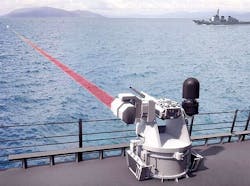Air Force researchers choose three companies to develop new directed-energy weapons materials
Officials of the U.S. Air Force Research Laboratory at Wright-Patterson Air Force Base, Ohio, has awarded contracts and task orders to the General Dynamics Corp. Information Technology segment in Fairfax, Va.; Azimuth Corp. in Beavercreek, Ohio; and to UES Inc. in Dayton, Ohio, to advance materials technologies that control and protect light and electromagnetic energy sources.
The Air Force Research Lab on Friday announced a contract for the three companies to share as much as $121.1 million for materials research and survivability studies involving hardened materials, survivability, and photonic materials. The project involves materials to create and protect from electro-optical weapons and RF and microwave weapons.
The three companies will work on advancing hardened materials for sensor protection; hardened structural materials; and personnel and aircrew protection. The goal is to add capabilities and increased survivability for aircrews and systems that lead to increased mission effectiveness for the warfighter, Air Force officials say.
Key areas of project include optical materials and processing; hardening materials and processing; electro-optic and infrared sensor protection; warfighter protection; structural protection; optical technology; studies on functional materials; threat defeat; and high-energy laser source materials.
The program focuses on agile limiters research; high-performance optical coatings' visor-based aircrew protection; optical materials, ceramics, and processing technologies; and RF photonics and hybrid optical apertures.
Also on Friday Azimuth Corp. won a $9.6 million task order as part of the overall program to develop new ceramic materials for laser gain media and plasmonic systems for optical components and devices.
Separately on Friday, Azimuth won an $8.7 million program task order to develop new materials that protect aircrews against friendly and hostile lasers operating in the visible and near infrared spectral regions.
Related: New Russian directed-energy weapon could complicate U.S. military strategic planning
UES, meanwhile, won a $9.4 million program task order on Friday to concentrate on radio frequency (RF) photonics and hybrid optical apertures by developing advanced materials for advanced RF photonic components, plasmonic and hybrid aperture schemes, and materials for next-generation systems.
RF photonics refers to using light for processing, transmitting, and generating RF signals, which can offer significant advantages to military systems by decreasing the size and power consumption of RF systems like communications and radar, as well as increasing RF bandwidth far beyond what can be obtained in pure electronic systems.
On these contracts and task options the contractors will do most of the work at Air Force Research Lab facilities at Wright-Patterson Air Force Base in Dayton, Ohio. Azimuth will do additional work in Camarillo and Santa Rosa, Calif. These task orders should be finished by early 2020.
For more information contact General Dynamics Information Technology online at www.gdit.com; Azimuth Corp. at www.azimuth-corp.com; UES at www.ues.com, or the Air Force Research Lab at www.wpafb.af.mil/AFRL.
